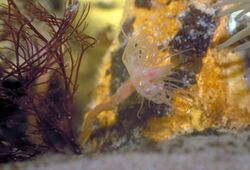Biology:Ectopleura larynx
| Ectopleura larynx | |
|---|---|

| |
| Ectopleura larynx | |
| Scientific classification | |
| Domain: | Eukaryota |
| Kingdom: | Animalia |
| Phylum: | Cnidaria |
| Class: | Hydrozoa |
| Order: | Anthoathecata |
| Family: | Tubulariidae |
| Genus: | Ectopleura |
| Species: | E. larynx
|
| Binomial name | |
| Ectopleura larynx Ellis & Solander, 1786
| |
| Synonyms | |
| |
Ectopleura larynx, or ringed tubularia, is a hydroid in the family Tubulariidae.[1]
Distribution
Ectopleura larynx is found throughout the British Isles and is common in the Northern Atlantic Ocean.[2]
Description
Ectopleura larynx forms colonies that are usually no more than 6 cm high.[3] It is described as:
The stems are tubular, with a yellowish coloured tegument and are branched at the base. The polyp colour is pale pink through to red, and consists of a central circlet of oral tentacles surrounded by paler but larger aboral tentacles[4]
Habitat
Ectopleura larynx is usually found on rocks or attached to algae.[5] It is most common in shallow water, fouling piers and on the undersides of boats; in the British Isles, seas surrounding Great Britain, and the Americas. E. larynx grows in colonies and can tolerate exposed habitats and strong water currents.[6]
References
- ↑ Telnes, K.. "Ringed Tubularia - Tubularia larynx". seawater.no. http://www.seawater.no/fauna/cnidaria/larynx.html.
- ↑ Picton, B.E.; Morrow, C.C.. "Tubularia larynx Ellis & Solander, 1786. [In Encyclopedia of Marine Life of Britain and Ireland."]. habitas.org.uk. http://www.habitas.org.uk/marinelife/species.asp?item=D1450.
- ↑ "WoRMS - World Register of Marine Species - Tubularia larynx Ellis & Solander, 1786". marinespecies.org. http://www.marinespecies.org/aphia.php?p=taxdetails&id=117995.
- ↑ "hydrozoans and Tubularia Larynx"
- ↑ Tubularia Larynx Ellis & Solander, 1786." Tubularia Larynx - Marine Life Encyclopedia. Encyclopedia of Marine Life of Britain and Ireland. Web.
- ↑ Hughes, R. G. "The Life-history of Tubularia Indivisa (Hydrozoa: Tubulariidae) with Observations on the Status of T. Ceratogyne." Tubularia.
Wikidata ☰ Q2714402 entry

